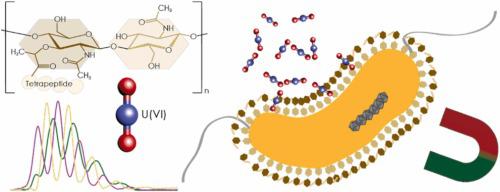Journal of Hazardous Materials ( IF 12.2 ) Pub Date : 2022-06-17 , DOI: 10.1016/j.jhazmat.2022.129376 Evelyn Krawczyk-Bärsch 1 , Justus Ramtke 2 , Björn Drobot 1 , Katharina Müller 1 , Robin Steudtner 1 , Sindy Kluge 1 , René Hübner 3 , Johannes Raff 1

|
The U(VI) bioassociation on Magnetospirillum magneticum AMB-1 cells was investigated using a multidisciplinary approach combining wet chemistry, microscopy, and spectroscopy methods to provide deeper insight into the interaction of U(VI) with bioligands of Gram-negative bacteria for a better molecular understanding. Our findings suggest that the cell wall plays a prominent role in the bioassociation of U(VI). In time-dependent bioassociation studies, up to 95% of the initial U(VI) was removed from the suspension and probably bound on the cell wall within the first hours due to the high removal capacity of predominantly alive Magnetospirillum magneticum AMB-1 cells. PARAFAC analysis of TRLFS data highlights that peptidoglycan is the most important ligand involved, showing a stable immobilization of U(VI) over a wide pH range with the formation of three characteristic species. In addition, in-situ ATR FT-IR reveals the predominant strong binding to carboxylic functionalities. At higher pH polynuclear species seem to play an important role. This comprehensive molecular study may initiate in future new remediation strategies on effective immobilization of U(VI). In combination with the magnetic properties of the bacteria, a simple technical water purification process could be realized not only for U(VI), but probably also for other heavy metals.
中文翻译:

肽聚糖作为污染水体中 Magnetospirillum magneticum AMB-1 上铀生物缔合的主要结合基序
使用结合湿化学、显微镜和光谱学方法的多学科方法研究了磁螺旋菌AMB-1 细胞上的 U(VI) 生物关联,以更深入地了解 U(VI) 与革兰氏阴性细菌的生物配体的相互作用,以更好地研究分子理解。我们的研究结果表明,细胞壁在 U(VI) 的生物结合中起重要作用。在与时间相关的生物结合研究中,高达 95% 的初始 U(VI) 从悬浮液中去除,并且可能在最初几个小时内结合在细胞壁上,因为主要是活的Magnetospirillum magneticum具有高去除能力AMB-1 细胞。TRLFS 数据的 PARAFAC 分析强调肽聚糖是最重要的配体,表明 U(VI) 在很宽的 pH 范围内稳定固定,并形成三个特征物种。此外,原位ATR FT-IR 揭示了与羧基官能团的主要强结合。在较高的 pH 值下,多核物种似乎发挥了重要作用。这项全面的分子研究可能会在未来有效固定 U(VI) 的新修复策略中启动。结合细菌的磁性,一个简单的技术水净化过程不仅可以用于 U(VI),而且可能还可以用于其他重金属。











































 京公网安备 11010802027423号
京公网安备 11010802027423号